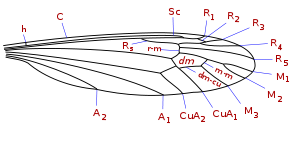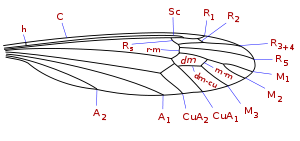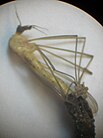Crane fly
| Crane fly Temporal range:
| |
|---|---|

| |
| Nephrotoma appendiculata(spotted crane fly) | |
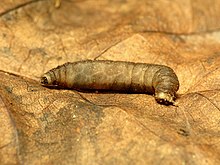
| |
| Crane fly larva | |
| Scientific classification | |
| Domain: | Eukaryota |
| Kingdom: | Animalia |
| Phylum: | Arthropoda |
| Class: | Insecta |
| Order: | Diptera |
| Infraorder: | Tipulomorpha |
| Superfamily: | Tipuloidea Latreille,1802 |
| Families | |
| |
Acrane flyis any member of thedipteransuperfamilyTipuloidea,which contains the living familiesCylindrotomidae,Limoniidae,PediciidaeandTipulidae,as well as several extinct families. "Winter crane flies", members of the familyTrichoceridae,are sufficiently different from the typical crane flies of Tipuloidea to be excluded from the superfamily Tipuloidea, and are placed as their sister group withinTipulomorpha.
The classification of crane flies has been varied in the past, with some or all of these families treated as subfamilies,[1]but the following classification is currently accepted.[2][3][4][5][6](Species counts are approximate, and vary over time.)[4]
- InfraorderTipulomorpha
- Superfamily Tipuloidea (Typical Crane Flies)
- FamilyCylindrotomidae(Cylindrotomid or Long-Bodied Crane Flies, 67 species)
- FamilyLimoniidae(Limoniid Crane Flies, 10,786 species, possiblyparaphyletic)
- FamilyPediciidae(Hairy-eyed Crane Flies, 498 species)
- FamilyTipulidae(Large Crane Flies, 4,351 species)
- FamilyTrichoceridae(Winter Crane Flies)
In colloquial speech, crane flies are known asmosquito hawksor "skeeter-eaters",though they do not actually prey on adultmosquitosor other insects.[7][8]They are also sometimes called "daddy longlegs",[7]a name which is also used for arachnids of the familyPholcidaeand the orderOpiliones.Thelarvaeof crane flies are known commonly as leatherjackets.[7]
Crane flies first appeared during theMiddle Triassic,around 245 million years ago, making them one of the oldest known groups of flies,[9]andare found worldwide,though individual species usually have limited ranges. They are most diverse in thetropicsbut are also common in northern latitudes and high elevations.[10]
More than 15,500 species and over 500generaof crane flies have been described, the majority byCharles Paul Alexander,who published descriptions of 10,890 new species and subspecies, and 256 new genera and subgenera over a period of 71 years, from 1910 to 1981.[4][11]
Description
[edit]
Summary
[edit]An adult crane fly, resembling an oversized malemosquito,typically has a slender body and long,stilt-likelegs that are deciduous, easily coming off the body.[12][2]Like other insects, their wings are marked with wing interference patterns which vary among species, thus are useful for species identification.[13]They occur in moist, temperate environments such as vegetation near lakes and streams.[2]They generally do not feed, but some species consume nectar, pollen and/or water.[14]
Thewingspanis generally about1.0 to 6.5 cm (1⁄2to2+1⁄2in), though some species ofHolorusiacan reach11 cm (4+1⁄4in).[15]Theantennaehave up to 19 segments.[7]It is also characterized by a V-shaped suture or groove on the back of thethorax(mesonotum) and by its wing venation.[10]Therostrumis long and in some species as long as the head and thorax together.[16]
Larvae occur in various habitats including marshes, springs, decaying wood, moist soil, leaf litter, fungi, vertebrate nests and vegetation. They usually feed on decaying plant matter and microbes associated with this, but some species instead feed on living plants, fungi or other invertebrates.[12]
Formal
[edit]
Tipuloidea are medium to large-sized flies (7–35 mm,1⁄4–1+1⁄2in) with elongated legs, wings, and abdomen. Their colour is yellow, brown or grey.Ocelliare absent. Therostrum(a snout) is short to very short with a beak-like point called thenasus(rarely absent). The apical segment of the maxillary palpi is flagelliform (whip-like) and much longer than the subapical segment. The antennae have 13 segments (exceptionally 14–19). These are whorled, serrate, or ctenidial (comb-like). There is a distinct V-shaped suture between the mesonotalprescutumandscutum(near the level of the wing bases). The wings are monochromatic, longitudinally striped or marbled. In females the wings are sometimes rudimentary. The sub-costal vein (Sc) joins through Sc2 with the radial vein, Sc1 is at most a short stump. There are four, rarely (when R2 is reduced) three branches of the radial vein merging into the alar margin. The discoidal wing cell is usually present. The wing has two anal veins. Sternite 9 of the male genitalia has, with few exceptions, two pairs of appendages. Sometimes appendages are also present on sternite 8. The female ovipositor has sclerotized valves and the cerci have a smooth or dentate lower margin. The valves are sometimes modified into thick bristles or short teeth.
The larva is elongated, usually cylindrical. The posterior two-thirds of the head capsule is enclosed or retracted within the prothoracic segment. The larva is metapneustic (with only one pair ofspiracles,these on the anal segment of the abdomen), but often with vestigial lateral spiracles (rarely apneustic). The head capsule is sclerotized anteriorly and deeply incised ventrally and often dorsolaterally. The mandibles are opposed and move in the horizontal or oblique plane. The abdominal segments have transverse creeping welts. The terminal segments of the abdomen areglabrous,often partially sclerotized and bearing posterior spiracles. The spiracular disc is usually surrounded by lobe-like projections and anal papillae or lobes.
Biology
[edit]Adults have a lifespan of 10 to 15 days.[17]The adult female usually contains mature eggs as she emerges from herpupa,and often mates immediately if a male is available. Males also search for females by walking or flying. Copulation takes a few minutes to hours and may be accomplished in flight. The female immediatelyoviposits,usually in wet soil or mats ofalgae.Some lay eggs on the surface of a water body or in dry soils, and some reportedly simply drop them in flight. Most crane fly eggs are black in color. They often have a filament, which may help anchor the egg in wet or aquatic environments.[11]
Crane fly larvae (leatherjackets) have been observed in many habitat types on dry land and in water,[11]includingmarine,brackish,andfresh water.[16]They are cylindrical in shape, but taper toward the front end, and the head capsule is often retracted into the thorax. The abdomen may be smooth, lined with hairs, or studded with projections or welt-like spots. Projections may occur around the spiracles.[16]Larvae may eat algae, microflora, and living or decomposing plant matter, including wood. Some are predatory.[10][11]
Ecology
[edit]
Larval habitats include all kinds of freshwater, semiaquatic environments. Some Tipuloidea, includingDolichopeza,are found in moist to wet cushions of mosses or liverworts.Ctenophoraspecies are found in decaying wood or sodden logs.NephrotomaandTipulalarvae are found in dry soils of pasturelands, lawns, and steppe. Tipuloidea larvae are also found in rich organic earth and mud, in wet spots in woods where the humus is saturated, inleaf litteror mud, decaying plant materials, or fruits in various stages of putrefaction.
Larvae can be important in the soil ecosystem, because they process organic material and increase microbial activity.[11]Larvae and adults are also valuable prey items for many animals, including insects,spiders,fish,amphibians,birds,andmammals.[16]
Adult crane flies may be used for transport by aquatic species of themitefamilyAscidae.This is known asphoresis.[18]
Pest status
[edit]
Some members of the tipulid genusTipula,such as the European crane fly,Tipula paludosaand the marsh crane flyT. oleraceaare agricultural pests in Europe. The larvae of these species live in the top layers of soil where they feed on theroots,root hairs,crown, and sometimes the leaves of crops, stunting their growth or killing the plants. They are pests on a variety of commodities. Since the late 1900s,T. paludosaandT. oleraceahave becomeinvasivein the United States.[19][20][21]The larvae have been observed on many crops, including vegetables, fruits, cereals, pasture, lawn grasses, andornamental plants.
In 1935,Lord's Cricket Groundin London was among venues affected by leatherjackets. Several thousand were collected by ground staff and burned, because they caused bald patches on thepitchand the pitch took unaccustomed spin for much of the season.[22]
Phylogenetics
[edit]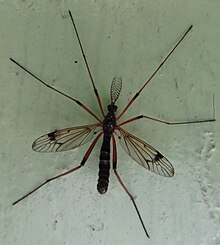
The phylogenetic position of the Tipuloidea remains uncertain. The classical viewpoint that they are an early branch of Diptera[23][24]—perhaps (with theTrichoceridae) thesister groupof all other Diptera—is giving way to modern views that they are more highly derived.[25]This is thanks to evidence from molecular studies, which is consistent with the morederivedlarval characters similar to those of 'higher' Diptera.[26]ThePediciidaeand Tipulidae are sister groups (the "limoniids" are a paraphyleticclade).[12]Specifically,Limoniidaehas recently been treated by numerous authors at the rank of family, but subsequentphylogeneticanalyses revealed that the remaining groups of tipulids render the groupparaphyletic.[12]TheCylindrotomidaeappear to be a relict group that was much better represented in theTertiary.[27]Tipulidae probably evolved from ancestors in the UpperJurassic,the Architipulidae, and representatives of theLimoniidaeare known from theUpper Triassic.
Common names
[edit]Numerous common names have been applied to the crane fly. Many of the names are more or less regional in the U.S., including mosquito hawk, mosquito eater, gallinipper, and gollywhopper.[28]They are also known as "daddy longlegs" in English-speaking countries outside the U.S.,[7]not to be confused with the U.S. usages of "daddy long legs" that refer to eitherarachnidsof the orderOpilionesor the familyPholcidae.Thelarvaeof crane flies are known commonly as leatherjackets.[7]
They are also known asJenny long legsin Scotland.[29]In Ireland, they are generally called 'daddy long legs' in English, whereas inIrishthey are commonly known asPilib an Gheataire,which means Skinny Philip.[29][30]
Misconceptions
[edit]There is an enduringurban legendthat crane flies are the most venomous insects in the world; however, they have neither venom nor the ability to bite.[31]The myth probably arose due to their being confused with thecellar spideras they are also informally called "daddy longlegs", and although the arachniddoes possess venom,it is not especially potent.[32]
Despite widely held beliefs that adult crane flies (or "mosquito hawks" ) prey on mosquito populations, the adult crane fly is anatomically incapable of killing or consuming other insects.[33]Although the adults of some species may feed on nectar, the adults of many species have such short lifespans that they do not eat at all.[34]
See also
[edit]- Tipularia discolor,the crane fly orchid
References
[edit]- ^Alexander C.P., Byers G.W. (1981) Tipulidae. in: McAlpine J.F. et al. (Ed.),Manual of Nearctic Diptera.Agriculture Canada, Ottawa, pp. 153–1902ISBN0-660-10731-7pdfArchived2013-12-01 at theWayback Machine
- ^abcZhang, Xiao; Kang, Zehui; Mao, Meng; Li, Xuankun; Cameron, Stephen L.; de Jong, Herman; Wang, Mengqing; Yang, Ding (2016)."Comparative Mt Genomics of the Tipuloidea (Diptera: Nematocera: Tipulomorpha) and Its Implications for the Phylogeny of the Tipulomorpha".PLOS ONE.11(6): e0158167.Bibcode:2016PLoSO..1158167Z.doi:10.1371/journal.pone.0158167.PMC4920351.PMID27341029.
- ^ Kolcsár, L-P; Oosterbroek, P; Gavryushin, DI; Olsen, KM; et al. (2021)."Contribution to the knowledge of Limoniidae (Diptera: Tipuloidea): first records of 244 species from various European countries".Biodiversity Data Journal.9:e67085.doi:10.3897/BDJ.9.e67085.PMC9848614.PMID36761998.
- ^abc Oosterbroek, Pjotr (2023)."Catalogue of the Craneflies of the World".Naturalis Biodiversity Center.Retrieved2023-06-13.
- ^ Zhang, Bing; Gao, Shang; Cao, Yike; Chang, Wencheng; Yang, Ding (2019)."The mitochondrial genome of Tipula (Formotipula) melanomera gracilispina (Diptera: Tipulidae)".Mitochondrial DNA Part B, Resources.4:240–241.doi:10.1080/23802359.2018.1546136.
- ^ "Tipulidae family Information".BugGuide.net.Retrieved2023-06-13.
- ^abcdefWatson, L. and M. J. Dallwitz. 2003 onwards.Tipulidae.British Insects: The Families of Diptera. Version: 1 January 2012.
- ^"Do Mosquito Hawks Eat Mosquitoes?".endmosquitoes.com.Retrieved29 August2019.
- ^Lukashevich, Elena D.; Ribeiro, Guilherme C. (2019-04-18)."Mesozoic fossils and the phylogeny of Tipulomorpha (Insecta: Diptera)".Journal of Systematic Palaeontology.17(8): 635–652.Bibcode:2019JSPal..17..635L.doi:10.1080/14772019.2018.1448899.ISSN1477-2019.
- ^abcPritchard, G (1983)."Biology of Tipulidae"(PDF).Annual Review of Entomology.28(1): 1–22.doi:10.1146/annurev.en.28.010183.000245.Archived fromthe original(PDF)on 2014-01-12.Retrieved2013-10-08.
- ^abcdeOosterbroek, P.Superfamily Tipuloidea, Family Tipulidae.Chapter 2 In: Evenhuis, N. L. (Ed.)Catalog of the Diptera of the Australasian and Oceanian Regions,Issue 86 of Bernice P. Bishop Museum Special Publication. Apollo Press. 1989.
- ^abcdPetersen, Matthew J.; Bertone, Matthew A.; Wiegmann, Brian M.; Courtney, Gregory W. (2010). "Phylogenetic synthesis of morphological and molecular data reveals new insights into the higher-level classification of Tipuloidea (Diptera)".Systematic Entomology.35(3): 526–545.Bibcode:2010SysEn..35..526P.doi:10.1111/j.1365-3113.2010.00524.x.S2CID86724439.
- ^Conrow, Robert T.; Gelhaus, Jon K. (2022-05-01)."Wing interference patterns are consistent and sexually dimorphic in the four families of crane flies (Diptera, Tipuloidea)".ZooKeys(1080): 135–163.Bibcode:2022ZooK.1080..135C.doi:10.3897/zookeys.1080.69060.ISSN1313-2970.PMC8755705.PMID35068968.
- ^Rodrigues, Lucas; Ortega, Ileana; Vieira, Rony; Carrasco, Daiane; Proietti, Maíra (2019)."Crane flies (Diptera, Tipuloidea) from southern Neotropical salt marshes: survey with DNA barcoding".Iheringia. Série Zoologia.109:e2019013.doi:10.1590/1678-4766e2019013.ISSN1678-4766.
- ^Louise Moon (25 April 2018)."'World's biggest' mosquito with 11 cm wing span found in southwest China ".South China Morning Post.Retrieved29 August2019.
- ^abcdde Jong, Herman; Oosterbroek, Pjotr; Gelhaus, Jon; Reusch, Herbert; Young, Chen (2008)."Global diversity of crane flies (Insecta, Diptera: Tipulidea or Tipulidae sensu lato) in freshwater"(PDF).Hydrobiologia.595(1): 457–467.doi:10.1007/s10750-007-9131-0.S2CID34927837.Archived fromthe original(PDF)on 2014-10-11.Retrieved2013-10-08.
- ^"Crane Flies:: Introduction".Archived fromthe originalon 2017-07-09.Retrieved2013-09-23.
- ^Smith, Ian M.; Smith, Bruce P.; Cook, David R. (2001),"Water Mites (Hydrachnida) and Other Arachnids",Ecology and Classification of North American Freshwater Invertebrates,Elsevier, pp. 551–659,doi:10.1016/b978-012690647-9/50017-x,ISBN978-0-12-690647-9,retrieved2022-10-06
- ^Rao, Sujaya; Listona, Aaron; Cramptonb, Lora; Takeyasu, Joyce (2006)."Identification of Larvae of ExoticTipula paludosa(Diptera: Tipulidae) andT. oleraceain North America Using MitochondrialcytBSequences ".Annals of the Entomological Society of America.99(1): 33–40.doi:10.1603/0013-8746(2006)099[0033:IOLOET]2.0.CO;2.S2CID85635147.
- ^Blackshaw, R.P.; Coll, C. (1999)."Economically important leatherjackets of grassland and cereals: biology, impact and control"(PDF).Integrated Pest Management Reviews.4(2): 145–162.doi:10.1023/A:1009625724013.S2CID80918734.Archived fromthe original(PDF)on 2014-01-15.Retrieved2019-08-29.
- ^Jackson D. M, Campbell R. L. Biology of the European crane fly, Meigen, in western Washington (Tipulidae: Diptera).Washington State University Technical Bull.No. 81. 1975.
- ^A. Ward (1999).Cricket's Strangest Matches(1998 ed.). Robson Books, London. p.111.ISBN978-1-86105-293-3.
- ^Rohdendorf, B. 1974. The Historical Development of Diptera. Edmonton: Univ. Alberta.
- ^Savchenko, E. N. 1966. Phylogeny and systematics of the Tipulidae.Fauna Ukraini14:63–88. In Russian.
- ^"Australian National Insect Collection (ANIC) Home".anic.csiro.au.Retrieved2023-01-04.
- ^Gullan, P. J., Cranston, P. S. 2014. The insects: an outline of entomology. 5th edition. West Sussex: Wiley Blackwell.
- ^Hennig,W. 1950.Die Larvenformen der Dipteren,Arb. 2. Berlin: Akad. Verlag.
- ^Cassidy, Frederic Gomes (1985).Dictionary of American Regional English.Belknap Press of Harvard University Press.ISBN978-0-674-20511-6.
- ^abHelena Horton (2021-09-22)."Is the UK really seeing a record daddy long legs invasion?".the Guardian.Retrieved2023-01-04.
- ^"Foclóir Gaeilge–Béarla (Ó Dónaill): Crane-fly".www.teanglann.ie.Retrieved2023-09-24.
- ^"Could record 200 billion daddy-long-legs hit UK? - CBBC Newsround".Retrieved2023-01-04.
- ^Ryan, Nicky (2013-10-20)."Debunked: Are Daddy Longlegs the most poisonous spiders in the world?".TheJournal.ie.Retrieved2023-01-04.
- ^Mertz, Leslie (August 17, 2015)."Mosquito Hawk? Skeeter Eater? Giant Mosquito? No, No, and No".Entomology Today.Entomological Society of America.
- ^Blake Newton."Crane Flies of Kentucky – University of Kentucky Entomology".
Further reading
[edit]- Identification
- R. L. Coe, Paul Freeman & P. F. Mattingly Nematocera: families Tipulidae to Chironomidae (Tipulidae).Handbooks for the Identification of British InsectsVol 9 Part 2 i.pdf
- J.F. McAlpine, B.V. Petersen, G.E. Shewell, H.J. Teskey, J.R. Vockeroth, D.M. Wood. Eds. 1987 Manual of Nearctic Diptera Volume 1 Research Branch Agriculture Canada, 1987pdfkey to Nearctic genera
- Pierre C.,1924, Diptères: TipulidaeFaune de Francen° 8Bibliotheque Virtuelle NumeriqueOut of date but online at no cost. In French.
- E. N. Savchenko Family Tipulidae inBei-Bienko, G. Ya,1988Keys to the insects of the European Part of the USSRVolume 5 (Diptera) Part 2 English edition. Keys to Palaearctic species but now needs revision.
External links
[edit]- Ohioline.osu.edu,Ohio State University Fact Sheet
- Family Tipulidae at EOL
- IZ.carnegiemnh.org,Crane Flies of Pennsylvania, Extensive Specimen Collection, Carnegie Museum of Natural History
- https://ccw.naturalis.nl/,Catalog of Craneflies of the World
- Diptera.info,Image Gallery
- BugGuide.net,photo gallery, many species
- Crane Fly,Field Guide to Common Texas Insects
- "CRANE FLY LARVAE".Missouri Department of Conservation.Retrieved27 September2020.

